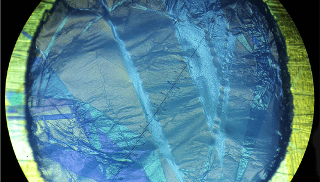May 9 2017
Organic semiconductor nanosheets, that can be effortlessly removed from a growth substrate and then placed on other substrates, have been recently developed by Scientists at LMU Munich and FSU Jena. This new development prevents the need for error-prone evaporation deposition, printing or drop casting.
 A 50 nm pentacene film spanned across a 2 mm hole. Capture: Simon Noever, LMU
A 50 nm pentacene film spanned across a 2 mm hole. Capture: Simon Noever, LMU
Computer processors that currently exist are made up of billions of transistors. These electronic components generally comprise of an electrode, substrate, insulator and semiconductor material. A number of scientists dream of having each of these elements in the form of transferable sheets, which could enable them to design new electronic devices by just stacking.
This has now turned into a reality for the organic semiconductor material pentacene: Dr. Bert Nickel, a physicist at LMU Munich and Professor Andrey Turchanin from Friedrich Schiller University Jena. Together with their teams they have, for the very first time, succeeded in developing mechanically stable pentacene nanosheets.
This method has been described by the researchers in the journal Advanced Materials. A small silicon wafer is first covered with a thin layer of a water-soluble organic film. This is followed by depositing pentacene molecules upon it until a layer almost 50 nm thick has formed. This next step is important, the topmost three to four levels of pentacene molecular layers are crosslinked by irradiation with low-energy electrons in order to form a 'skin' that is only about 5 nanometers thick. This crosslinked layer stabilizes the whole pentacene film in a manner that it can be removed as a sheet from a silicon wafer in water and then moved to another surface using ordinary tweezers.
Besides being capable of transferring them, the new semiconductor nanosheets have several other advantages. For instance, the new method does not need any potentially interfering solvents. Additionally, the nanosheet sticks strongly to the electrical contacts by van der Waals forces, leading to a low contact resistance of the final electronic devices. Thus, it is now possible to deposit organic semiconductor nanosheets onto significantly more technologically relevant substrates than before.
The extremely high mechanical stability of the newly developed pentacene nanosheets is of particular interest as this characteristic enables them to be applied as free-standing nanomembranes to perforated substrates with dimensions of tens of micrometers. This indeed corresponds to spanning a 25-meter pool with plastic wrap.
These virtually freely suspended semiconductors have great potential. They can be accessed from two sides and could be connected through an electrolyte, which would make them ideal as biosensors, for example.
Dr. Bert Nickel, LMU Munich
"Another promising application is their implementation in flexible electronics for manufacturing of devices for vital data acquisition or production of displays and solar cells,” Turchanin says.